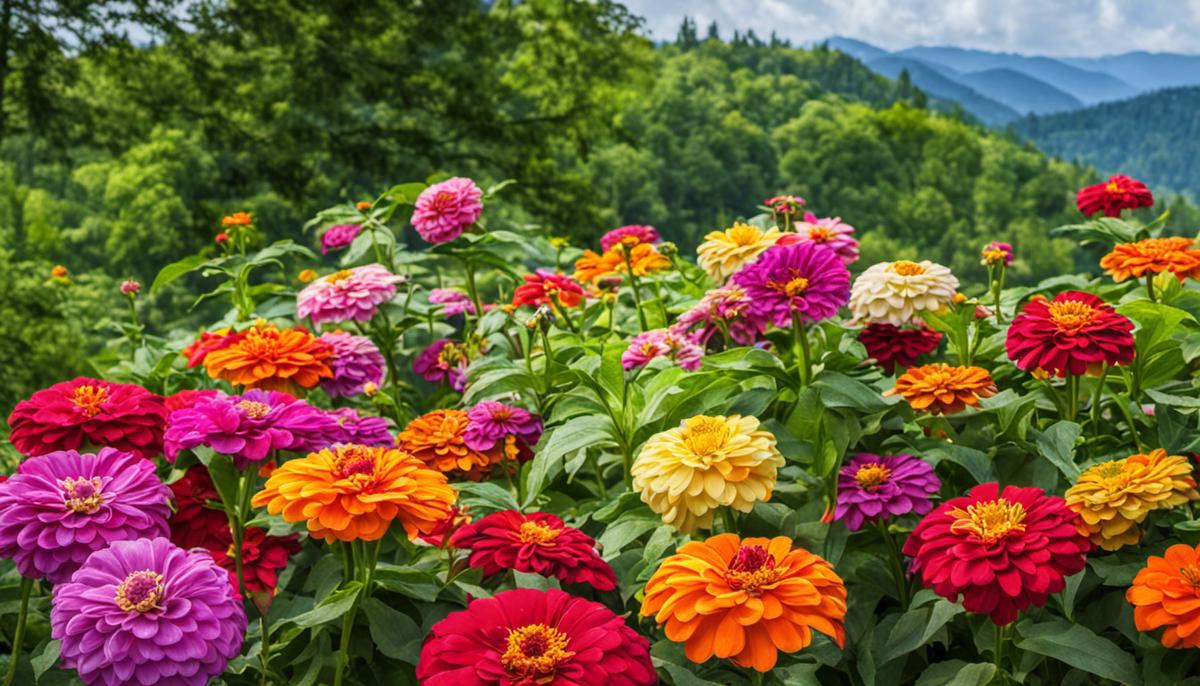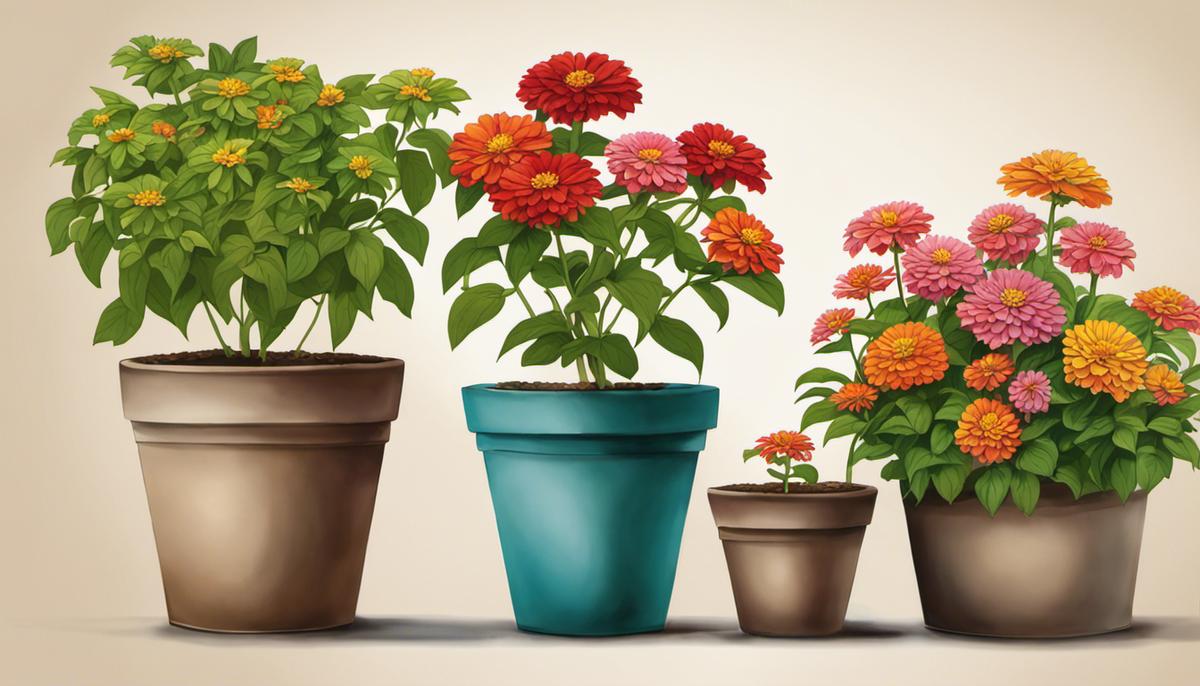How many Zinnia plants per pot? With their enchanting array of colors and species, are the darling of gardeners and flower enthusiasts alike. However, to effectively cultivate these beautiful blooms, several factors come into play.
This exploration delves into the intricacies of zinnia growth, shedding light on the ideal soil, temperature, sunlight exposure, and spacing for these magnificent garden flowers. It zeroes in on understanding the dynamic relationship these factors maintain with zinnia growth, enabling you to determine the optimum number of zinnias you should plant in a single pot.
How many Zinnia plants per pot
Understanding Zinnias: Knowing the Basics
Zinnias, a favorite among many gardeners, are vibrant flowering plants. Growing zinnias mainly requires observing specific factors such as soil type, temperature, sun exposure, and proper plant spacing.
Ideal Soil for Zinnias
If you are looking to plant zinnias, start by choosing the right soil. These plants thrive best in organically rich, well-draining soil. Zinnias are adaptable, however, and can still grow in average to slightly poor soils. The most important factor is ensuring good soil drainage as zinnias don’t tolerate waterlogged conditions well. A pH range between 5.5 and 7.5 is most conducive for healthy zinnia growth.

The Right Temperature and Sun Exposure
When it comes to temperature, zinnias prefer a warm climate. Ideally, temperatures should range between 74 to 84 degrees Fahrenheit. Anything too low or too high can stunt their growth or cause them to wilt.
As for sunlight, these plants need a high amount of sun exposure. They require at least six hours of full sun daily. If you are growing this plant indoors, make sure that the spot is sufficiently sunny, or consider using a grow light.
Proper Spacing for Effective Growth
The actual spacing for zinnias depends on the variety you choose. Larger varieties need to be spaced about 18 to 24 inches apart. Smaller varieties can be placed closer together, around 6 to 9 inches apart. In terms of potted zinnias, a general rule is one plant per 12-inch pot. Always ensure there is ample space for air circulation as crowded conditions can lead to disease.
When considering how many zinnia plants to place in your pot, refer to all these factors. Applying adequate spacing, choosing the right soil, and providing the required temperature and sun exposure is essential for successful zinnia growth. As always, the ultimate goal is to ensure that your zinnias bloom in a manner as brilliant and vibrant as they are intended to be.

Pot Size and Zinnia Planting
Understanding Pot Size and Zinnia Planting
The impact of the pot’s size is substantial when planting Zinnias. Generally, Zinnias need adequate space for root growth and general development. Each pot can comfortably accommodate a predetermined number of seeds or seedlings, depending on its size. Crowding the Zinnias can lead to relatively low production and poor growth due to competition for nutrients, water, and light.
Small Pots for Zinnia Planting
Typically, small pots have a diameter of 8 inches or less. Use small pots for starting your Zinnia seeds, as this size provides enough space for the seeds to germinate and start growing. However, these pots can only effectively hold one Zinnia plant. Growing more than one Zinnia in a small pot can cause overcrowding, poor air circulation, and insufficient nutrients for optimal growth.
Medium Pots for Zinnia Planting
Medium pots usually range in diameter from 10 to 14 inches. These pots provide more space for the Zinnias’ roots to spread and establish. However, it is all about balance, as excessive space could lead to overwatering and root rot. A medium pot can comfortably accommodate two Zinnia plants. Position the Zinnias far enough apart to promote healthy growth without competition for essential resources.
Large Pots for Zinnia Planting
For larger pots with a diameter of 16 inches or more, you could plant up to four or five Zinnias, depending on the Zinnia variety. The large pot provides ample space for root development, allowing the Zinnia plants to mature nicely. It also enables adequate buffer space among the Zinnias, limiting the risk of disease transmission.
Pot Size and Watering Zinnia Plants
The size of the pot also influences the watering needs of the Zinnias. Smaller pots tend to dry out faster, so they may need more frequent watering compared to larger pots. However, take care not to overwater any Zinnias, as this can lead to root rot and other moisture-related diseases. Always check the soil moisture before watering.
Pot Size and Fertilizer Application for Zinnia Plants
Similarly, the pot size may affect the amount of fertilizer required by the Zinnia plants. Less fertilizer is required for smaller pots than larger ones. Over-fertilization can lead to excessive growth of leaves at the expense of flowers or burn the roots, so be careful with the quantity applied regardless of your pot size.

How to maximize zinnia blooms
Maximizing the blooms of your zinnias involves a combination of proper care, planting techniques, and maintenance. Here are some steps you can take to ensure your zinnias produce abundant and vibrant blooms:
Choose the Right Location:
Zinnias thrive in full sunlight. Select a location in your garden that receives at least 6 to 8 hours of direct sunlight per day. They prefer well-draining soil with good air circulation.
Soil Preparation:
Zinnias prefer well-draining soil with a slightly acidic to neutral pH (around 6.0 to 7.5). Amend the soil with compost or well-rotted organic matter to improve its texture and fertility.
Proper Planting:
Plant zinnia seeds or transplants after the last frost in your area. Space the plants according to the variety’s recommended spacing. Planting too closely can lead to poor air circulation and an increased risk of disease.
Watering:
Zinnias appreciate regular, deep watering to keep the soil evenly moist. However, avoid overwatering, as zinnias don’t like soggy soil. Water at the base of the plants to prevent fungal diseases, and consider using a soaker hose or drip irrigation to keep the foliage dry.
Fertilization:
Zinnias are relatively heavy feeders. Apply a balanced, water-soluble fertilizer every 4-6 weeks during the growing season. Follow the instructions on the fertilizer packaging for application rates. Over-fertilizing can lead to excessive foliage growth at the expense of blooms.
Deadheading:
Regularly remove spent flowers (deadheading) to encourage continuous blooming. Deadheading prevents the plant from putting energy into producing seeds and redirects that energy toward new flower production.
Mulching:
Apply a layer of organic mulch around the base of the zinnias. Mulch helps retain moisture, suppress weeds, and maintain a more even soil temperature.
Pest and Disease Control:
Keep an eye out for common pests like aphids, spider mites, and caterpillars. If you notice any infestations, take appropriate measures to control them. Also, provide good air circulation and avoid overhead watering to prevent fungal diseases.
Supporting Tall Varieties:
Some zinnia varieties can become tall and top-heavy. Consider providing support, such as stakes or cages, to prevent the plants from flopping over.
Variety Selection:
Different zinnia varieties have varying growth habits, flower sizes, and colors. Choose varieties that are well-suited to your climate, garden space, and preferences.
Successive Planting:
To ensure a prolonged blooming season, consider planting zinnias in successive batches, spaced a few weeks apart. This can provide you with blooms throughout the growing season.
Regular Inspection:
Check your zinnias regularly for signs of stress, disease, or pest infestations. Catching problems early allows you to address them before they severely impact plant health and flowering.
How Often Should I Water Potted Zinnias?
The frequency of watering potted zinnias depends on several factors, including the size of the pot, the type of soil, the weather conditions, and the overall moisture retention capacity of the potting mix. Here are some guidelines to help you determine how often to water potted zinnias:
Check the Moisture Level: Before watering, always check the moisture level of the potting mix. Stick your finger about an inch or two into the soil. If it feels dry at that depth, it’s time to water. If it’s still slightly moist, you can wait a bit longer.
Consider Pot Size: Smaller pots tend to dry out more quickly than larger ones because they have a limited volume of soil to hold moisture. If your zinnias are in small pots, you might need to water more frequently.
Environmental Conditions: Hot and windy weather can lead to faster evaporation of moisture from the soil. During such conditions, you might need to water more often. Similarly, if the humidity is low, the soil can dry out faster.
Type of Potting Mix: The type of potting mix you use can influence water retention. High-quality potting mixes with good moisture retention properties will require less frequent watering compared to lower-quality mixes.
Drainage: Proper drainage is crucial for potted plants. Make sure the pots have drainage holes to allow excess water to escape. Waterlogged soil can lead to root rot and other problems.
Watering Technique: When you water, make sure to water thoroughly until you see water draining out of the bottom of the pot. This ensures that the entire root ball is adequately moistened.
Seasonal Changes: As the weather changes, so will the water requirements of your potted zinnias. During cooler periods or the rainy season, you might need to water less frequently.
Overall
Consider your pot size and the chosen variety of Zinnia when planning how many plants to grow per pot. Provide adequate space, correct watering, and proper fertilization to ensure that each Zinnia thrives and produces a profusion of beautiful flowers.

The impact of pot size on planting zinnias cannot be downplayed; it is as crucial as the planting process itself. Considered in tandem with the factors affecting zinnia growth, it forms a well-rounded backdrop for successful zinnia cultivation.
Getting familiar with different pot sizes will give you a head start on deciding the appropriate number of zinnia plants per pot. Armed with this information, we aim to help you create and enjoy a thriving multicolored spectacle characterized by optimal growth of your zinnia plants.






